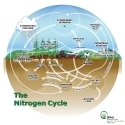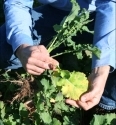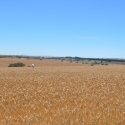17 Aug 2016
Nitrogen mid-season
Yes - No - Wait
 Rainfall front coming through
Rainfall front coming through
In many parts of southern Australia, winter rains have been kind and crop yield potentials are good to very good. Every year – good or bad – yield potentials and the on-going crop N demand should be reviewed to build a strategy to use the water available.
With a starting point of 40 kg N per tonne of estimated wheat yield, a target N demand can be calculated. So, for a 4 t/ha wheat crop, the target N would be 160 kg N/ha. If the yield potential increases, then so does N demand. The demand is the “easy” side of the equation – although any yield estimate is just that – an estimate. For canola, the N demand is about 80 kg N per tonne of estimated yield.
The supply side is a little more difficult to assess. Many growers will have measured deep soil N at or near seeding, and may have provided some fertilizer N earlier. The sum of these is the starting N. For example, mineral N at seeding could be 60 kg N/ha and another 10 kg N/ha supplied at seeding and an early topdressing of 30 kg N/ha. This makes a total N of 100 kg/ha – enough for a bit over a 2.5 t/ha.
The other contributor to supply is the mineralisation of N from organic matter. The amount supplied – and to be supplied from now on - is more difficult to assess. Warm, moist soils and high organic matter levels promote mineralisation. Over a crop season, soil with 1% organic carbon could mineralise 50 kg N/ha depending on temperature and soil moisture. An N-rich strip would give an indication of the supply up until this time including mineralised N – so if not part of the 2016 program think carefully about this for 2017.
Then there are losses of N – and this year the big one is most likely denitrification – where mineral N is converted to gaseous N (nitrous oxides and dinitrogen) and lost to the system. The amounts here are difficult to estimate and can be large. If the paddock has been waterlogged and has high soil carbon, then over the warmer part of the season N losses can be high. Again, an N-rich strip would assist in assessing that loss, but seeing yellowed crops in wetter parts of the paddock suggest losses can be high.
The main difference between making decisions for wheat and canola is that canola can still show yield responses to late N, while late N on wheat will most likely end up as protein.
Just like in cricket - there are three calls to make:
- “YES” – if the crop has yellowed lower leaves/tillers, and the N supply estimate is less than the potential N demand – that is the yield potential.
- “NO” – if the crop is N supply is near to the potential N demand, and the soil has high mineralisation potential.
- “WAIT” – if the paddock is flooded wait until it is trafficable and then reassess the yield potential. It may mean patching out the paddock avoiding drowned areas of crop. The later N is applied, the smaller the yield response to applied N but the higher the likelihood of a response in protein.







